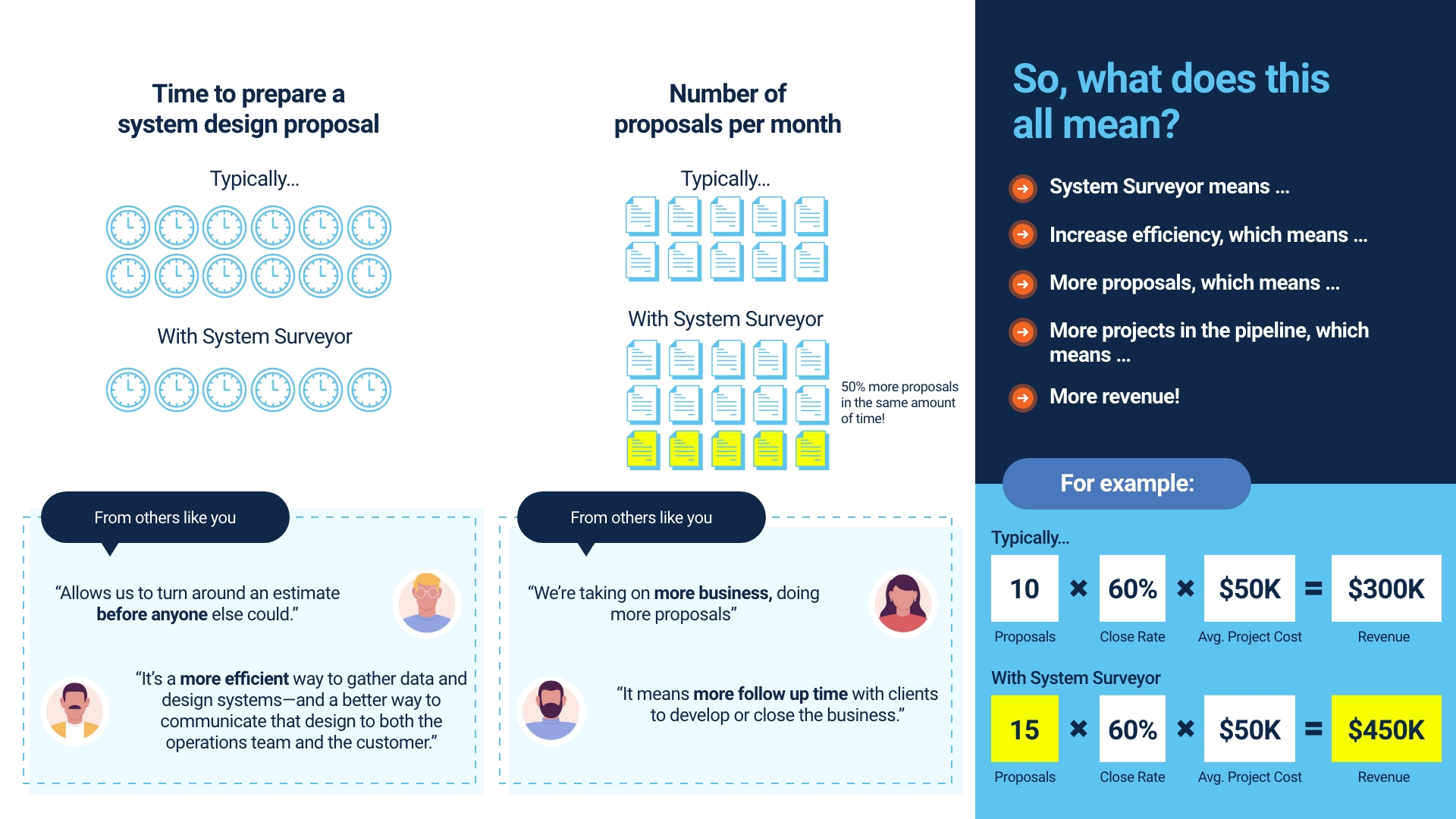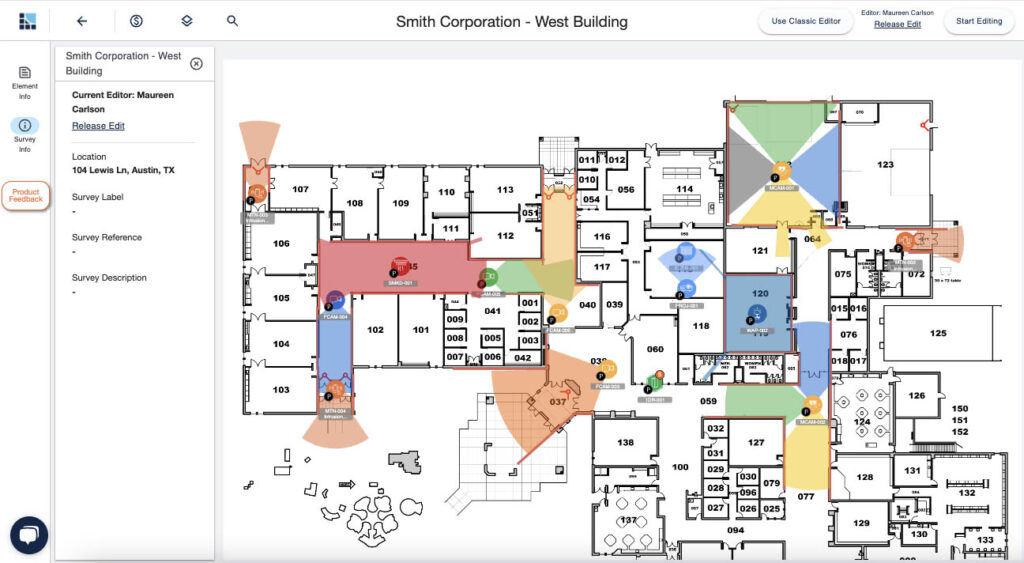Low Hanging Fruit to Energize the Business
Running a system integration business can be rewarding, but let’s be honest: it isn’t always easy.
Oftentimes, the problem isn’t a lack of available work; it’s maximizing output and capacity so you can go after more of that high value work.
Too often, the core processes that underly the ability to design and deliver are the culprint. In particular, the process for site surveys and physical security system design are manual, error-prone, and unscalable. It may be these are underlying challenges to scaling the business. You’re too busy doing the work to address it.
If this sounds a little too familiar, then this summer may be the perfect time to take stock:
- What’s working well?
- What areas are underperforming?
- Where can you reinvent or outperform the industry status quo?
Boost Performance with 5 Fast Fixes
This post highlights 5 areas where system integrators can pragmatically make a difference to the bottomline. We pair each common challenge with one with a quick, actionable fix that can move the needle without requiring a full overhaul.
Think of these as “tune-ups”: small but mighty adjustments that sharpen your execution, improve profit margins and keep your team focused on what matters most.
Problem 1:
Clogged or unhealthy pipelines
Many system integrators are facing hard limits on growth because of problems with their ability to get quality system designs and estimates together for proposals in an efficient and timely manner.
The two primary issues:
- Inconsistent Site Surveys and Design Process: Every sales person or estimator is doing the process a bit differently and use up to 10-12 hours or more on an average design (at minimum). Time kills deals and prospects can start looking around.
- Poor Collaboration Process for Design: For a quality design and estimate, a few people are typically involved. The problem may be that there is not a good way to gather photos and details to share it with those involved in design. It is not sustainable to send multiple resources to site surveys. This creates a bottleneck and slow and inefficient design.
This is the number one problem we hear about time and again. The good news is that it is addressable.
Quick Fix 1:
Simplify & templatize system design and proposal generation
One of the quickest ways to address backlogs or problems with your pipeline is to spend more productive, efficient time on each client and lead.
Imagine what you could do if you could spend half the time you do now on system designs and proposals. (Answer: you could create 50% more – which fills pipeline with revenue!).
The typical integrator uses 10-12 hours for a site survey to system design for a proposal. Cut that to 5-6 hours and you simply have time to do a few more proposals. That is what builds more pipeline opportunity. But, beware to sacrifice on quality of the design or you risk it not being profitable.
I have yet to meet a Director or VP of sales who is not looking for more productivity for their team and to add high quality opportunity to their pipeline.

This is easy back of the napkin math:
Greater efficiency → more decision-ready proposals → more projects in the pipeline → more won jobs → more revenue
If you could get a 50%-time savings on system designs and feed the pipeline with 50% more designs and proposals, how would that move the needle for the second half of the year?
So, look at your system design process. Where could you save time? What tools could help you do this faster and easier? Can any aspects of your proposal process be templated?
System Surveyor is an ideal solution for simplifying and speeding up system design. See how integrators can cut time in half by switching to System Surveyor: read the Prosegur case study.
Problem 2:
Profitability expectations vs. reality
Another problem facing system integrators is that sometimes the money just isn’t there: profit margins look good on paper, but accounting tells a different story.
There are all sorts of reasons why this could happen. Estimate accuracy could be a culprit here: if you’re regularly quoting too low, profitability will take a big hit. Accuracy in the sales to ops handoff can be an issue as well: if your sales team promised something that doesn’t function or exist, or if they leave key system elements off their estimates, you’ll encounter issues once ops goes to build those systems.
quick fix 2:
Re-evaluate your design and estimation process
Review a few of your last security projects. Were there go-backs, were there any change orders? While there will be some, try to define where the problem stems from.
- Was there a clear site survey, was everything captured?
- Was the original estimation off and were there missing accessories or installation clarity?
- Was the design reviewed by a manufacturer partner and could that have helped?
Doing this kind of reflection isn’t all that difficult or time-consuming, but it could reveal some changes that can boost project margins. Get the team together and get honest in the spirit of improving it and determine where the main pain point or opportunity exists.
Problem 3:
Labor limitations
Every industry report suggest that labor is one of the biggest challenges. You probably have a great team and if you are like most, you have to run lean. Most system integrators struggle to hire and retain qualified, experienced staff sufficiently to meet demand. Labor limitations can put a cap on the number of projects you can take on and can contribute to the first two problems we covered.
The sneaky problem here is labor utilization: how much output are you getting for your labor’s effort? The status quo in system integration is frustratingly inefficient, with round upon round of back-and-forth between a salesperson, estimator, and client considered just a normal part of doing business.
quick fix 3:
Streamline or simplify a recurring task
The ultimate solution here is making your labor and your processes more efficient. One quick, low-lift way to do this? Isolating specific tasks to simplify and possibly automate.
Even one automation can free up hours of your team’s time, allowing them to reinvest that time into more valuable tasks.
Two quick tips here:
- Use Favorite Elements: While the average integrator sells several components of a solution, most everyone has their favorite elements that they use 80-90% of the time. Make site surveys and design easier by establishing and tagging your Favorites.
- Automate a Bill of Materials: One of the top opportunities in the pre-sales process is to automate a Bill of Materials during site surveys and system design. While you drag and drop system icons, imagine an easy way to select products and start to build a BOM as you go. As an example, with System Surveyor, companies can build or use Manufacturer Element Profiles (or catalogs) to take hours off the normal process of re-entry.
Problem 4:
Margin pressure and lack of recurring revenue
System integrators also face pressure on profit margins, sometimes even from their better customers. Part of this has to do with the typical security system lifecycle and the way that businesses think about physical security infrastructure. When they buy a video surveillance system or an access control system, they expect it to last them a decade or more. They hope not to need you in any meaningful way in the interim.
No wonder you’re facing margin pressures if most of your customers spend big just once a decade!
quick fix 4:
Offer add-on and recurring services to existing clients
is changing, and so should this “once a decade” attitude and approach.
Consider upselling your current customers on additional service lines or replacement tech that adds new capabilities. In most cases, upselling is faster and easier than new selling. Depending on the industry, acquiring a new client is approximately 5-7 times more expensive than selling to an existing one.
System Surveyor makes upselling easy because you can visualize with the customer whatnew tech can do. For example, retrofitting an existing building or system with AI cameras can add new capabilities. The key is the ability to visualize and do a budget estimate together. Help them and visualize what they would gain through new investment. 
Bonus tip: look for ways to turn this consultant role into recurring revenue. Maybe this looks like maintenance or service contracts on a tech-forward system. Maybe it looks like “phys sec as a service” — any way you can create long-term, ongoing value for clients is a possible source of recurring revenue.
Problem 5:
Sales and ops teams risk falling behind
As the physical security industry continues to change, some with experience in the industry are failing to evolve along with it. Before long, sales teams aren’t pushing the best solutions for a given situation because they don’t understand them well enough to sell them. Ops teams run into challenges installing new solutions for similar reasons.
Over time, the overall quality of a system integration business can drop as they lose their competitive edge.
quick fix 5:
Upskill techs to maintain your edge
If you’re heading into a summer slump, take advantage of the downtime: upskill your team members to help maintain your edge. High-demand platforms, new vendors (or old vendors offering products with new capabilities), and industry groups all offer various training and certifications your team can pursue during the down weeks.
The System Surveyor Certification Program is one option: this free program helps your talent understand how to get the most out of our modern, collaborative site survey and system design platform.
Now is the best time to strengthen your talent bench to get the most out of our cloud-based site survey and system design platform. Upskill your team now so you can hit the ground running in the fall!
Summer months will go fast, get started:
Get a FREE Starter Account on System Surveyor
Select one of these quick fixes and see immediate results.
